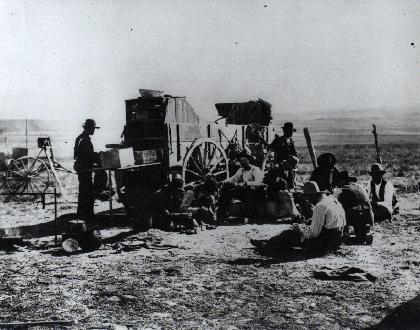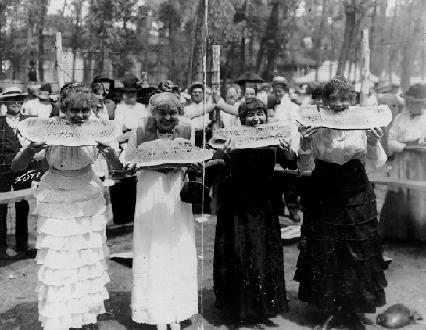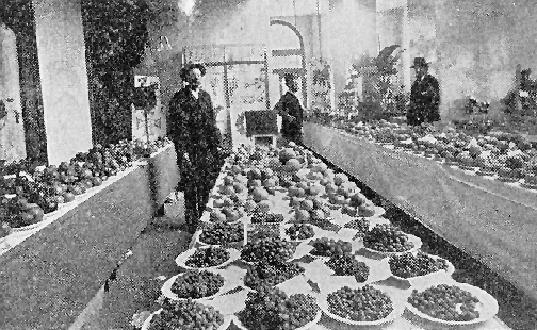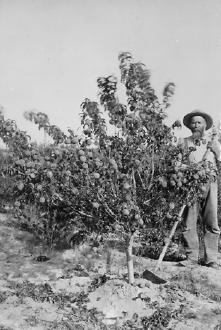Food
What do these photos tell you about the kind of food people ate?
Cowboys Around a Chuck Wagon
This photo was taken on the plains of Eastern Colorado during a roundup. The cowboys are eating beside a chuck wagon. Cowboys ate a lot of beef during roundups. Cowboys also drank coffee and ate biscuits, beans and other vegetables.

Photo: Colorado Historical Society
More About This Topic
Colorado was a major beef-producing state. By 1880, cattle had replaced the herds of bison that once grazed on the plains of eastern Colorado. The cattlemen sold some of the animals to butchers who sold meat to people who lived in the towns and cities of Colorado. Most of the cattle were shipped to meat-packing plants in eastern cities.
Their Own Words
"The food on a roundup was always of the best. A fat calf would be killed for meat and this with potatoes, canned tomatoes, beans, and bread baked in a Dutch oven, would satisfy the appetite of the hardest riding cowboy. And one may be sure that after a hard day's ride with only a sandwich or two, and those eaten while riding, appetites were not lacking... Each man's grub would be handed out to him by the cooks, dished up on a tin plate. He found a comfortable seat on a rock or the wagon tongue and ate. At night each man crawled into his own tent or slept out under the stars, rolled in a blanket."
Source: Frank Loustalet (1934), CWA Interviews, Doc. 343/41, Colorado Historical Society.
Melon Day in Rocky Ford
This photo was taken at Rocky Ford, Colorado in the late 1800s. The women are eating watermelons. Rocky Ford was famous for its watermelons and cantaloupes. It celebrated the melon harvest each summer by holding a Melon Day festival.

Photo: Colorado Historical Society
More About This Topic
Farmers in Colorado raised thousands of melons and cantaloupes each year. Melons grew well in the sandy soil of the Arkansas Valley. The town of Rocky Ford celebrated the harvest each year with a Melon Day Festival.
Their Own Words
“This is the first occasion of these festivities. . . . Large tables were built in the public square, on which were piled hundreds of specimens of the crisp and juicy fruit [watermelons]. The guests were also provided with a free dinner, composed of the numerous other products of the Arkansas Valley. . . . The Santa Fe [Railroad] Company ran out several large excursion trains.”
Source: Denver Republican, September 15, 1888, quoted in Therese S. Westermeier, “Colorado Festivals (Part III),” Colorado Magazine, 30 (July 1953): 194-95.
Colorado State Fair (1893)
This photo was taken at the Colorado State Fair in the early 1890s. Farmers brought vegetables and other foods to display at the fair. These tables are filled with plates of tomatoes, potatoes, and other vegetables waiting to be judged.

Photo: Colorado Historical Society
More About This Topic
The early settlers of Colorado grew most of the vegetables they needed. The rich soil produced large crops of tomatoes, onions, potatoes, and other vegetables. Some farmers specialized in growing vegetables. They sold them to the mining camps in the mountains and to towns and cities along the Front Range. Food grown nearby was cheaper than canned goods that had to be hauled across the plains. Vegetables still are an important crop in Colorado.
Their Own Words
"The first year there were but seven families in the settlement. . . . We managed to get in some garden: corn, melons, pumpkins, squash, Mexican beans and some hay, and cleared some ground of sagebrush. We raised quite a lot of chickens, ducks, and turkeys. By assisting each other we managed to raise and store away enough produce to run us part way through the winter, which was a very cold one."
Source: O. T. Jackson, quoted in Karen Waddell, "Dearfield... A Dream Deferred," Colorado Heritage, 2 (1988): 5.
Farmer In His Orchard
This photo was taken at a fruit orchard near Grand Junction, Colorado. The farmer was using a hoe to clear out weeds from around a peach tree.

Photo: Colorado Historical Society
More About This Topic
During the first years of settlement, fruit in Colorado was very expensive. Apples sold for $1.25 each in Denver in 1859, which would be more than $10.00 apiece today. Farmers in many parts of Colorado tried growing apples, peaches, plums, and other fruit. The Western Slope near Grand Junction proved to be the best fruit growing area in Colorado. It became famous for its fine peaches.
Their Own Words
"Most of our fruit came from our own orchard. Dad had set out apple trees that bore fruit from July on, and the long-lasting varieties kept until the next spring. We had currants, gooseberries, raspberries, cherries, plums, and pears. I can still see the glasses of jelly set up on the window ledge to catch and reflect the sun and be admired. Before the Mason jar, fruits were dried or preserved in sugar. Sugar and flour were bought in one-hundred-pound bags and lard in fifty-pound pails or tins. "
Source: Hazel Webb Dalziel, "The Way It Was," The Colorado Magazine, 45 (Spring 1968): 111.

